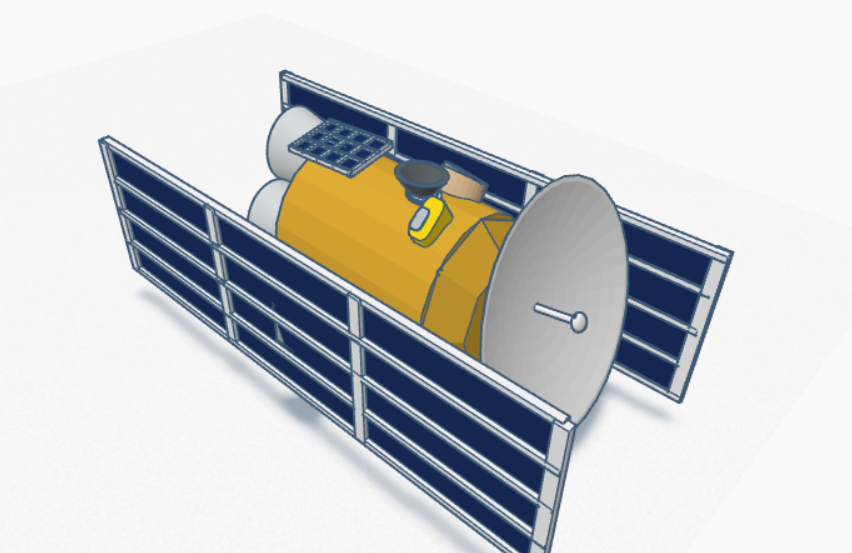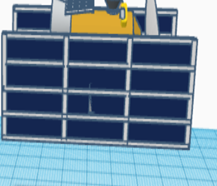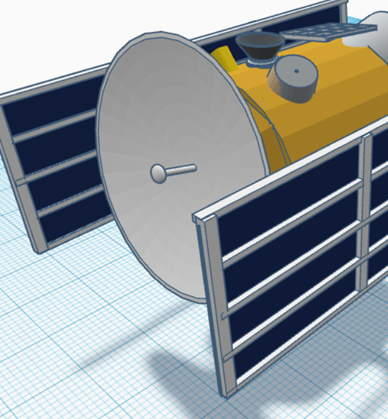-
bookCourses
Description:
Here Givemefive Student, Meenakshi Shubash presents a project called ‘Mission Red Dawn 008’.
Meenakshi beautifully explained her 3d model satellite designed using tinkercad, she explained the different parts of a satellite and their functions.
Introduction:
The name of my satellite is red dawn 008, it’s a satellite designed to orbit the atmosphere and gather important information on the planet.
Structures:
My satellite is drum shaped, which allows it to maintain stability and it is made up of lightweight but sturdy material such as titanium and carbon composites, its structure holds together the entire satellite and shields it from meteorite and damage.
Power:
The satellite uses solar energy to power up, the solar energy is used to power up the batteries and rest of the satellite, during the solar eclipse, the batteries are used to run the satellites
Thermal Power:
The satellite has a couple of systems to ensure thermal control.it uses heat pipes or radiator to maintain the temperature within the satellite, it’s also covered with multi layered insulation that protects it from extreme temperature differences.
Altitude determination and control:
The satellite uses sensors and alarms that helps in achieving orbit control, it consists of position sensors that helps in tracking the satellite and alarms that alert when there are any off-truck disturbances, it depends on three axis stabilization method, it uses thruster and reaction wheels that helps maintain the course of the satellite, the thruster uses solar electric propulsion. Solar electric converts the solar energy obtained from the panels to electric energy and this energy is used up to power up the thrusters. This way the satellite is made ten times more fuel efficient and its lighter weight as it does have to carry the weight of the fuel.
Telemetry:
The satellite is also equipped with a telemetry device. Telemetry systems update the ground station on factors like the satellite health’s, measurement and current information that it has collected from external planets. If there is any kind of problem, the ground station produces a suitable solution and sends a command over to the telemetry device to perform the needed changes.
Communication Payload:
The communication payload consists of the antenna and transponders of the satellite. The antenna transmit and receive signals while transponders translate and increase the strength of the signals, the satellite has two transponders with a parabolic antenna.
Instruments:
1. Mars color imager: identifies and monitors clouds and dust storms.
2. Camera that helps with navigation.
3. A radar that helps detect spots where there are polar ice caps and minerals.
4. Systems that help in observing and studying the Martian atmosphere.
5. Flight computers: used to estimate satellites time of travel and ground speed.

Structure and Shape
My satellite is drum shaped, which allows it to maintain stability and it is made of lightweight but sturdy material such as titanium and carbon composites. Its structure holds together the entire satellite and shields it from meteorite collision and damage.
Thermal Systems
My satellite has a couple of systems to ensure thermal control. It uses heat pipes or radiators to maintain the temperature within the satellite. It’s also covered with multi layered insulation that protects it from extreme temperature differences.
Power

The satellite uses solar energy to power up. The solar energy is used to power up the batteries and the rest of the satellite. During solar eclipses, the batteries are used to run the satellite.
Attitude Determination and Control
My satellite uses sensors and alarms that help in achieving orbit control. It consists of position sensors that help in tracking the satellite and alarms that alert when there are any off-track disturbances. It depends on the 3 axis stabilization method. It uses thrusters and reaction wheels that help maintain the course of the satellite. The thrusters use solar electric propulsion. Solar electric propulsion converts the solar energy obtained from the panels to electrical energy and this energy is used up to power up the thrusters. This way the satellite is made ten times more fuel efficient and its lighter weight as it does not have to carry the weight of the fuel.
Telemetry
My satellite is also equipped with a telemetry device. Telemetry system updates the ground station on factors like the satellite’s health, measurements, and current information that it has collected from an external planet. If there is any kind of problem, the ground station produces a suitable solution and sends a command over to the telemetry device to perform the needed changes.

Communications payload
Communications payload consists of the antennae and the transponders of the satellite. The antennae transmit and receive the signals while the transponders translate and increase the strength of the signal. My satellite has two transponders (an extra transponder just in case the first one fails) with a parabolic antenna.

Instruments